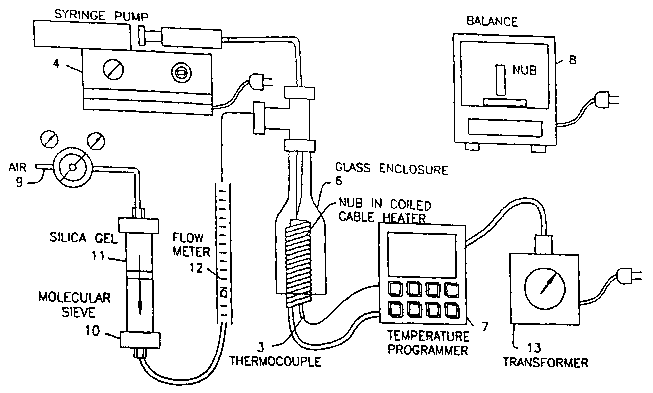Une partie des informations de ce site Web a été fournie par des sources externes. Le gouvernement du Canada n'assume aucune responsabilité concernant la précision, l'actualité ou la fiabilité des informations fournies par les sources externes. Les utilisateurs qui désirent employer cette information devraient consulter directement la source des informations. Le contenu fourni par les sources externes n'est pas assujetti aux exigences sur les langues officielles, la protection des renseignements personnels et l'accessibilité.
L'apparition de différences dans le texte et l'image des Revendications et de l'Abrégé dépend du moment auquel le document est publié. Les textes des Revendications et de l'Abrégé sont affichés :
| (12) Demande de brevet: | (11) CA 2477765 |
|---|---|
| (54) Titre français: | SYSTEME ET PROCEDE SERVANT A DETERMINER LA TENDANCE A L'ENCRASSEMENT PAR DES CHARGES DE RAFFINERIE |
| (54) Titre anglais: | SYSTEM AND METHOD FOR DETERMINING FOULING TENDENCY BY REFINERY FEED STOCKS |
| Statut: | Réputée abandonnée et au-delà du délai pour le rétablissement - en attente de la réponse à l’avis de communication rejetée |
| (51) Classification internationale des brevets (CIB): |
|
|---|---|
| (72) Inventeurs : |
|
| (73) Titulaires : |
|
| (71) Demandeurs : |
|
| (74) Agent: | BORDEN LADNER GERVAIS LLP |
| (74) Co-agent: | |
| (45) Délivré: | |
| (86) Date de dépôt PCT: | 2003-03-04 |
| (87) Mise à la disponibilité du public: | 2003-09-25 |
| Licence disponible: | S.O. |
| Cédé au domaine public: | S.O. |
| (25) Langue des documents déposés: | Anglais |
| Traité de coopération en matière de brevets (PCT): | Oui |
|---|---|
| (86) Numéro de la demande PCT: | PCT/US2003/006555 |
| (87) Numéro de publication internationale PCT: | WO 2003078693 |
| (85) Entrée nationale: | 2004-08-27 |
| (30) Données de priorité de la demande: | |||||||||
|---|---|---|---|---|---|---|---|---|---|
|
L'invention concerne un système et un procédé servant à évaluer des charges de raffinerie afin de déterminer la formation de dépôts sur leurs surfaces.
A system and method for determining the fouling tendency of refinery feed
stocks using a solid block nub (1) with a deposit surface (6). A gas and feed
stock is directed to the deposit surface (6) on the nub (1). The nub (1) is
heated using a coil heater (2). The heated nub (1) in turn heats the air/feed
stock simulating a refinery condition on the deposit surface (6). The nub (1)
is weighed before and after the simulation, with the change in weight
representing the fouling deposits from the feed stock.
Note : Les revendications sont présentées dans la langue officielle dans laquelle elles ont été soumises.
Note : Les descriptions sont présentées dans la langue officielle dans laquelle elles ont été soumises.

2024-08-01 : Dans le cadre de la transition vers les Brevets de nouvelle génération (BNG), la base de données sur les brevets canadiens (BDBC) contient désormais un Historique d'événement plus détaillé, qui reproduit le Journal des événements de notre nouvelle solution interne.
Veuillez noter que les événements débutant par « Inactive : » se réfèrent à des événements qui ne sont plus utilisés dans notre nouvelle solution interne.
Pour une meilleure compréhension de l'état de la demande ou brevet qui figure sur cette page, la rubrique Mise en garde , et les descriptions de Brevet , Historique d'événement , Taxes périodiques et Historique des paiements devraient être consultées.
| Description | Date |
|---|---|
| Demande non rétablie avant l'échéance | 2009-03-04 |
| Le délai pour l'annulation est expiré | 2009-03-04 |
| Inactive : Abandon.-RE+surtaxe impayées-Corr envoyée | 2008-03-04 |
| Réputée abandonnée - omission de répondre à un avis sur les taxes pour le maintien en état | 2008-03-04 |
| Inactive : CIB de MCD | 2006-03-12 |
| Inactive : CIB de MCD | 2006-03-12 |
| Inactive : Page couverture publiée | 2004-11-01 |
| Lettre envoyée | 2004-10-28 |
| Lettre envoyée | 2004-10-28 |
| Inactive : Notice - Entrée phase nat. - Pas de RE | 2004-10-28 |
| Demande reçue - PCT | 2004-09-27 |
| Exigences pour l'entrée dans la phase nationale - jugée conforme | 2004-08-27 |
| Demande publiée (accessible au public) | 2003-09-25 |
| Date d'abandonnement | Raison | Date de rétablissement |
|---|---|---|
| 2008-03-04 |
Le dernier paiement a été reçu le 2006-12-21
Avis : Si le paiement en totalité n'a pas été reçu au plus tard à la date indiquée, une taxe supplémentaire peut être imposée, soit une des taxes suivantes :
Veuillez vous référer à la page web des taxes sur les brevets de l'OPIC pour voir tous les montants actuels des taxes.
| Type de taxes | Anniversaire | Échéance | Date payée |
|---|---|---|---|
| Enregistrement d'un document | 2004-08-27 | ||
| Taxe nationale de base - générale | 2004-08-27 | ||
| TM (demande, 2e anniv.) - générale | 02 | 2005-03-04 | 2005-02-21 |
| TM (demande, 3e anniv.) - générale | 03 | 2006-03-06 | 2006-01-19 |
| TM (demande, 4e anniv.) - générale | 04 | 2007-03-05 | 2006-12-21 |
Les titulaires actuels et antérieures au dossier sont affichés en ordre alphabétique.
| Titulaires actuels au dossier |
|---|
| EXXONMOBIL RESEARCH AND ENGINEERING COMPANY |
| Titulaires antérieures au dossier |
|---|
| MICHAEL SISKIN |
| SIMON R. KELEMEN |